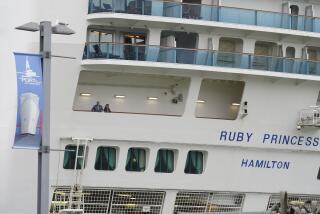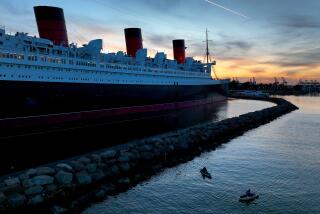Onboard medical facilities have cruise passengers covered
- Share via
“They lost my bag, with all my drugs, and my doctor says I’ll die if I don’t take that pill,” the cruise passenger told the ship’s doctor. He wanted the doctor to give him a replacement medication from the onboard pharmacy.
The doctor asked whether the patient knew what the medication was for.
He didn’t.
Did he know what it was called?
Nope.
Was there anything noticeable about the pill itself?
Yes, he said. “It was red. It was a little red pill.”
The story, said Grant Tarling, vice president and fleet medical officer for Princess and Cunard cruise lines, shows how cruise ship medical centers still coddle forgetful and needy landlubbers. But they also have become state-of-the-art critical-care facilities.
Tarling and other cruise line medical officers said that the facilities markedly improved about 10 years ago when maritime medical facilities came under the regulation of the American College of Emergency Physicians.
But getting sick on a cruise ship can cost you. Seeing the ship’s doctor for, say, a sore throat is $56 on any of the Crystal ships, $60 on a Carnival or Princess ship and $75 on Holland America.
Most of the lines charge an additional fee for after-hours doctor visits and more than $125 for a cabin visit, depending on whether a nurse’s assistance is also required. Fees for a nurse start at about $15.
Two X-rays will run about $80. Blood tests may be in the hundreds, although the price depends on the number of tests.
Aspirin, seasickness pills and Tylenol are generally free, but you will pay about 10% over retail for prescription drugs. Most ships have a store that sells over-the-counter drugs for lesser maladies.
Other treatments and diagnostic equipment now routinely available to passengers include defibrillators, electrocardiograms, cardiac-monitoring machines, ventilators and nebulizers.
If you require an emergency air ambulance and are not insured for it, you better have an extra $15,000 on hand when the medical evacuation team leader knocks on your door.
The good news: Cruise lines generally bill these costs directly to passengers’ shipboard accounts, and most say they will work with passengers’ insurance carriers to minimize out-of-pocket expenses. Many cruise cancellation policies also provide coverage for medical evacuation.
Cruise lines, travel agencies and independent insurance companies offer full-service plans that cover medical insurance and cancellation.
Carnival, for instance, joined with AIG to underwrite a travel policy that pays up to $30,000 for medical evacuation and $10,000 for sickness and medical costs for the duration of the cruise. It also covers accidents, cancellations and trip delays. Coverage costs $39 per passenger for a three-day cruise and $99 for a six- to nine-day voyage.
Such policies are readily available from all the lines, and they generally are competitively priced.
Tarling, Princess and Cunard’s fleet medical officer, touted his line’s Princess Travel Care plan, noting that its limits were as high as $50,000 (for gold coverage) and that it covered preexisting illnesses.
Whether a passenger needs insurance depends on age, medical history and a variety of personal factors. You also should check to see what your primary medical coverage provides.
Odds are you won’t need supplemental insurance or medical care, for that matter.
In 2004, about one in six of Holland America’s 698,359 passengers visited an onboard medical center, most for minor issues such as seasickness, said Sally van Boheemen, director of fleet medical operations at Seattle-based Holland America Line and Windstar Cruises.
Van Boheemen noted that 608 of those were disembarked with medical problems.
In the same period, Carnival carried about 3 million passengers and disembarked 1,200 for sickness, and Crystal Cruises carried 66,552 passengers and had to remove 42 for medical reasons.
Tarling said the smaller Princess ships, such as the 600-passenger liners that sail the South Seas, generally are staffed with one doctor and two nurses.
The 3,000-passenger jumbo ships that sail the Caribbean typically have a second doctor and up to five nurses. Most of the line’s ships have eight beds in their medical centers that serve as intensive-care, examination, isolation and critical-care units with cardiac and other types of diagnostic machines and monitors.
Although most cruise lines emphasize that their facilities are not intended for surgical procedures (short of setting fractured bones and stitching up cuts), Crystal Cruises, the Los Angeles-based upscale line, requires its nurses to be certified to administer anesthesia just in case.
Lynn Sogi, a Crystal spokeswoman, said her line’s three ships each carry one doctor and two nurses, and have five to seven overnight beds.
Despite the high-tech capabilities, most of these medical centers were really designed as first stops before more extensive medical care on land.
“All of our ships are within 12 hours of port,” said Steve Williams, director of medical operations for Miami-based Carnival Cruise Lines. “Our goal is to stabilize [patients] and get them to a shore-based facility.”
Until then, the shipboard facilities can be lifesavers. Williams recounts the story of a passenger who won $3,500 in a casino slot machine and immediately suffered a heart attack.
At the ship’s medical center, he was given a lifesaving clot-busting drug. Cost for a single dose: $3,000.
The passenger had no recollection of winning a jackpot, and his wife told the doctor not to tell him.
Because financially it was a wash, Williams said, “She figured, why upset him with what it all cost.”
*
Comments on this Travel Insider column can be directed to travel@latimes.com or Travel Insider, Los Angeles Times, 202 W. 1st St., Los Angeles, CA 90012. We regret that we cannot respond individually.
More to Read
Sign up for The Wild
We’ll help you find the best places to hike, bike and run, as well as the perfect silent spots for meditation and yoga.
You may occasionally receive promotional content from the Los Angeles Times.






